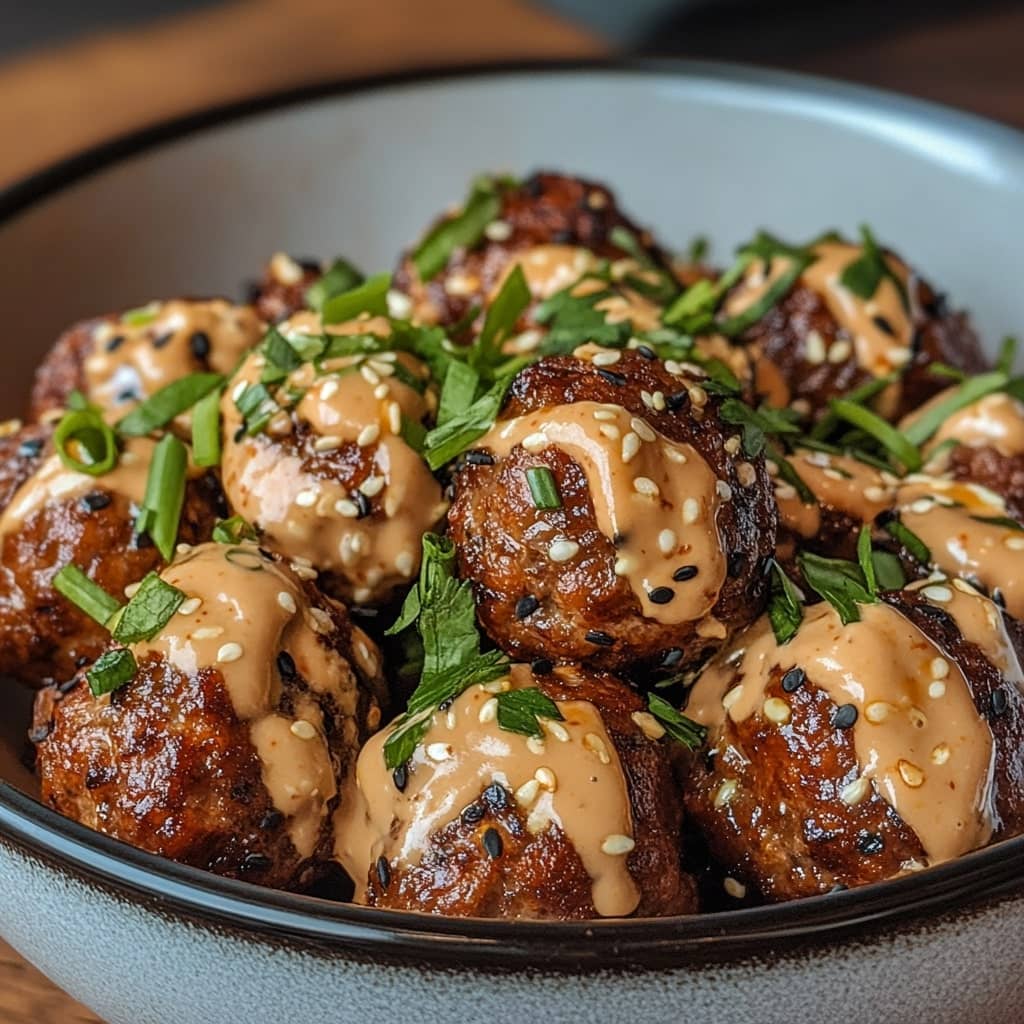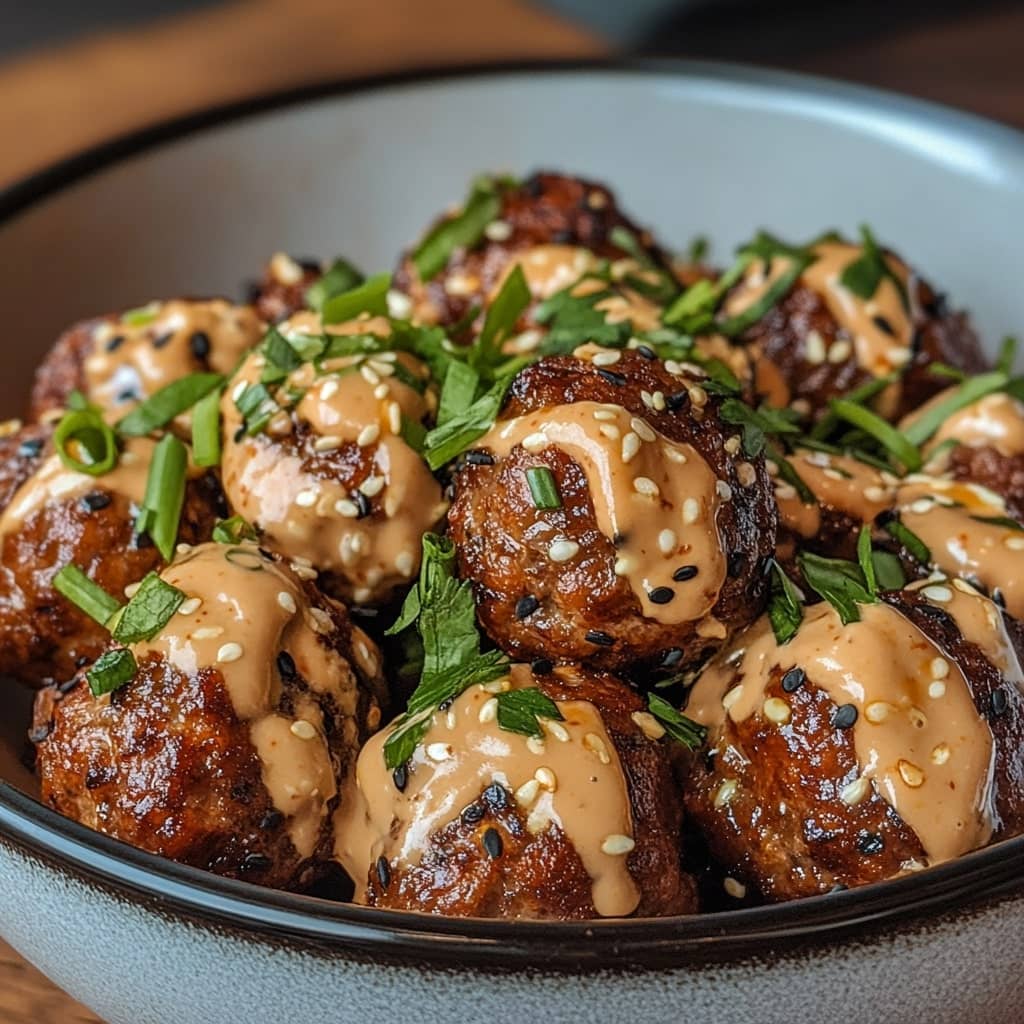Introduction
Korean BBQ Meatballs with Spicy Mayo Dip combine the bold, umami-rich flavors of traditional Korean barbecue with the fun and crowd-pleasing format of bite-sized meatballs. These savory, slightly sweet, and garlicky meatballs are made from ground meat infused with classic Korean seasonings such as soy sauce, sesame oil, garlic, and ginger, then glazed with a sticky Korean-style BBQ sauce. Paired with a creamy and spicy mayo-based dipping sauce that adds just the right amount of heat, this dish is a delicious fusion of East Asian flavors and Western comfort food appeal. Perfect as an appetizer, game day snack, or even a main course served over rice or noodles, Korean BBQ Meatballs bring a flavorful twist to the table that’s sure to satisfy a wide range of palates. Whether you’re hosting a dinner party or meal-prepping for the week, these meatballs offer convenience without sacrificing taste, and the spicy mayo dip provides a perfect balance of creaminess and heat to complement the savory meatballs.
The History of Korean BBQ Meatballs
The roots of this flavorful fusion dish lie in the centuries-old tradition of Korean barbecue, or “gogigui,” a method of grilling marinated meats, typically beef, pork, or chicken. Korean BBQ itself is deeply ingrained in Korean culture, often enjoyed in a communal setting where friends and family gather to grill meats at the table and share a wide variety of side dishes known as “banchan.” The marinade used for Korean BBQ typically features soy sauce, garlic, sugar, sesame oil, and green onions, creating a savory-sweet flavor that’s become popular globally. As Korean cuisine has grown in popularity around the world, particularly in the United States, creative reinterpretations have emerged, including Korean BBQ-inspired meatballs. These bite-sized adaptations retain the rich flavors of traditional marinades but package them in a way that’s easy to cook, serve, and eat. The spicy mayo dip draws inspiration from Korean condiments like gochujang (fermented red chili paste), blended with Western-style mayonnaise to create a tangy, creamy, and spicy contrast that enhances the meatballs’ bold flavor. This dish exemplifies modern Korean fusion cuisine—blending tradition with innovation, and satisfying food lovers across cultural boundaries.
Ingredients Breakdown
- Ground Meat: Typically beef, pork, or a mix of both, offering a juicy, flavorful base for the meatballs. Ground chicken or turkey can also be used for a leaner option.
- Breadcrumbs: Help bind the meatballs and give them structure while absorbing juices to stay moist.
- Egg: Acts as a binder to hold the ingredients together and create a tender texture.
- Soy Sauce: Delivers umami and saltiness, mimicking the flavor base of Korean BBQ marinades.
- Brown Sugar: Adds a hint of sweetness that balances the saltiness and enhances caramelization.
- Garlic & Ginger: Provide the classic aromatic backbone of Korean flavor profiles.
- Green Onions: Add a fresh, slightly sharp note to the mix.
- Sesame Oil: Offers a deep, nutty flavor that’s quintessential to Korean cooking.
- Gochujang (Optional): For a spicy kick and authentic Korean heat.
- For the Glaze: A mixture of soy sauce, brown sugar, garlic, sesame oil, and a touch of rice vinegar or mirin for tang.
- Spicy Mayo Dip: Made with mayonnaise, gochujang or sriracha, lime juice, and a dash of sesame oil, this creamy dip complements the meatballs with a spicy, tangy finish.
Step-by-Step Recipe
- Preheat the Oven: Set your oven to 400°F (200°C) and line a baking sheet with parchment paper or foil for easy cleanup.
- Make the Meatball Mixture: In a large bowl, combine 1 pound of ground beef or pork, ½ cup breadcrumbs, 1 egg, 2 tablespoons soy sauce, 1 tablespoon brown sugar, 1 tablespoon sesame oil, 2 cloves minced garlic, 1 teaspoon grated ginger, and 2 chopped green onions. Mix until just combined—do not overmix to avoid tough meatballs.
- Form the Meatballs: Using your hands or a scoop, roll the mixture into 1 to 1.5-inch balls and place them evenly spaced on the prepared baking sheet.
- Bake the Meatballs: Bake for 15–18 minutes, or until fully cooked through and lightly browned.
- Prepare the Korean BBQ Glaze: While the meatballs are baking, whisk together ¼ cup soy sauce, 2 tablespoons brown sugar, 1 tablespoon rice vinegar, 1 clove minced garlic, and 1 teaspoon sesame oil in a small saucepan. Simmer for 3–5 minutes until the sauce thickens slightly. Optional: add a teaspoon of gochujang for spice.
- Glaze the Meatballs: Once baked, brush the warm meatballs generously with the glaze or toss them in a bowl to fully coat.
- Make the Spicy Mayo Dip: In a small bowl, whisk together ½ cup mayonnaise, 1–2 tablespoons gochujang or sriracha (to taste), 1 teaspoon sesame oil, and 1 teaspoon lime juice. Adjust the heat level as desired.
- Serve: Arrange the glazed meatballs on a platter with a side of the spicy mayo dip. Garnish with sesame seeds and extra green onions if desired.
Tips for the Perfect Korean BBQ Meatballs
Use freshly minced garlic and ginger for the most vibrant flavor, and avoid overworking the meat mixture to keep the meatballs tender. Chilling the mixture for 15–20 minutes before forming the meatballs can help them hold their shape better during baking. For a deeper flavor, you can marinate the meat mixture for 30 minutes before shaping and cooking. Don’t skip the glaze—brushing or tossing the meatballs in the Korean BBQ sauce adds shine and extra layers of flavor. When making the spicy mayo dip, start with a smaller amount of gochujang or sriracha and adjust to your spice preference. For an even richer dip, add a touch of honey or sugar to balance the heat.
Variations and Customizations
These meatballs are versatile and can be adjusted to suit different tastes or dietary needs. Swap beef and pork for ground turkey or chicken for a leaner version. Add finely shredded carrots, zucchini, or cabbage for extra veggies and texture. For a gluten-free version, use tamari instead of soy sauce and gluten-free breadcrumbs. Try baking the meatballs and then finishing them in a skillet with the glaze for a crispy exterior. You can also skewer the meatballs for party-friendly presentation or serve them over rice, noodles, or in lettuce wraps for a full meal. For extra spice, add chopped chilies to the meat mixture or sprinkle crushed red pepper on top.
Health Considerations and Nutritional Value
Korean BBQ Meatballs are protein-rich and flavorful, but like many glazed or sauced dishes, they can be high in sodium and sugar. Using lean meat helps reduce fat content, and baking instead of frying cuts down on unnecessary oil. The spicy mayo dip is rich and flavorful but also calorie-dense, so consider using a light or avocado-based mayo for a healthier alternative. You can also reduce the sugar in the glaze or substitute it with natural sweeteners like honey or maple syrup. Adding vegetables to the meat mixture not only boosts nutrition but also increases moisture and fiber content. When portioned appropriately, these meatballs can be part of a balanced meal, especially when paired with whole grains and fresh vegetables.
FAQ
Q: Can I make these meatballs ahead of time?
A: Yes, the meatballs can be shaped and stored in the fridge up to a day ahead or frozen for up to 3 months before baking.
Q: How spicy is the spicy mayo dip?
A: The spice level is adjustable—use less gochujang or sriracha for a milder dip, or add more if you like extra heat.
Q: Can I fry the meatballs instead of baking?
A: Absolutely. Pan-fry the meatballs in a bit of oil over medium heat until browned and cooked through for a crispier exterior.
Q: What can I serve with these meatballs?
A: Serve them over jasmine rice, noodles, in lettuce wraps, or as part of a bento-style lunch box with kimchi, pickled veggies, and a salad.
Q: Is gochujang necessary for this recipe?
A: It’s optional but recommended for authentic flavor. If unavailable, sriracha or another chili paste can be used as a substitute.

Korean BBQ Meatballs with Spicy Mayo Dip
Ingredients
Method
- Prepare the Meatball Mixture: In a large bowl, combine the ground beef, panko breadcrumbs, egg, minced garlic, grated ginger, soy sauce, gochujang, brown sugar, sesame oil, salt, black pepper, and finely chopped green onions. Mix the ingredients gently until everything is evenly incorporated—avoid overmixing to keep the meatballs tender.
- Roll the mixture into uniform meatballs, approximately 1 to 1.5 inches in diameter, ensuring they are similar in size for even cooking.
- Pan-Fry Method: Heat a bit of oil in a large skillet over medium heat. Add the meatballs and cook, turning occasionally, until all sides are browned and the centers are fully cooked, about 10–12 minutes.
- Baking Method: Preheat your oven to 400°F (200°C). Place the meatballs on a parchment-lined baking sheet and bake for 18–20 minutes, or until cooked through.
- Preheat the air fryer to 375°F (190°C). Arrange the meatballs in a single layer and cook for 10–12 minutes, shaking the basket halfway through for even browning.
- Make the Korean BBQ Glaze: In a small saucepan over medium heat, combine soy sauce, honey or brown sugar, gochujang, rice vinegar, sesame oil, minced garlic, and minced ginger. Stir and bring to a simmer. Mix the cornstarch with water to create a slurry and slowly add it to the glaze, stirring until the sauce thickens to your desired consistency.
- Once the meatballs are cooked, place them in a bowl or return them to the skillet and pour the warm glaze over them. Toss or stir gently until the meatballs are evenly coated in the sauce.
- Make the Spicy Mayo Dip: In a separate small bowl, whisk together the mayonnaise, gochujang, lime juice, honey, and garlic powder until the dip is smooth and well blended.
- Arrange the glazed meatballs on a serving dish. Sprinkle with toasted sesame seeds and chopped green onions for garnish. Serve with the spicy mayo dip on the side for dipping.
Notes
For extra texture and crunch, sprinkle with chopped sesame seeds or crushed peanuts just before serving.
Modify the amount of gochujang or sriracha to match your desired level of spiciness.
